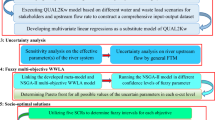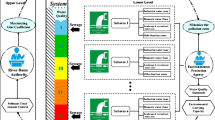Abstract
In this paper, a new methodology is developed for integrated allocation of water and waste-loads in river basins utilizing a fuzzy transformation method (FTM). The fuzzy transformation method is used to incorporate the existing uncertainties in model inputs. In the proposed methodology, the FTM, as a simulation model, is utilized in an optimization framework for constructing a fuzzy water and waste-loads allocation model. In addition, economic as well as environmental impacts of water allocation to different water users are considered. For equitable water and waste load allocation, all possible coalition of water users are considered and total benefit of each coalition, which is a fuzzy number, is reallocated to water users who are participating in the coalition. The fuzzy cost savings are reallocated using a fuzzy nucleolus cooperative game and the FTM. As a case study, the Dez River system in south-west of Iran is modeled and analyzed using the methodology developed here. The results show the effectiveness of the methodology in optimal water and waste-loads allocations under uncertainty.











Similar content being viewed by others
References
Aramaki, T., & Matsuo, T. (1998). Evaluation model of policy scenarios for basin-wide water resources and quality management in the tone river, Japan. Water Science and Technology, 38(11), 59–67.
Babel, M. S., Das Gupta, A., & Nayak, D. K. (2005). A model for optimal allocation of water to competing demands. Water Resources Management, 19, 693–712.
Burn, D. H., & Lence, B. J. (1992). Comparison of optimization formulations for waste-load allocations. Journal of Environmental Engineering, 118(4), 597–612.
Dezab Consulting Engineers (2001). Restoration of the Karoon-Dez river system, Technical Report.
Ghahraman, B., & Sepaskhah, A. R. (1997). Use of water deficit sensitivity index for partial irrigation scheduling of wheat and barley. Irrigation Science, 18, 11–16.
Ghosh, S., & Mujumdar, P. P. (2005). A fuzzy waste load allocation model integrating skewness of distributions. In: Proc. National Conference on Advances in Water Engineering for Sustainable Development (NCAWESD-2005), 16–17 May IIT Madras, India, pp 55–61.
Ghosh, S., & Mujumdar, P. P. (2006). Risk minimization in water quality control problems of a river system. Advances in Water Resources, 29(3), 458–470.
Ghosh, S., & Mujumdar, P. P. (2010). Fuzzy waste load allocation model: A multiobjective approach. Journal of Hydroinformatics, 12(1), 83–96.
Hanss, M. (2002). The transformation method for the simulation and analysis of systems with uncertain parameters. Fuzzy Sets and Systems, 130, 277–289.
Javier, P. A., Joaquín, A. A., Miguel, M., & Abel, S. (2010). Water quantity and quality models applied to the Jucar River Basin, Spain. Water Resources Management, 24(1), 2759–2779.
Karamouz, M., Zahraie, B., & Kerachian, R. (2003). Development of a master plan for water pollution control using MCDM techniques: A case study. Water International, 28(4), 478–490.
Karamouz, M., Tabari, M. M. R., & Kerachian, R. (2007). Application of genetic algorithms and artificial neural networks in conjunctive use of surface and groundwater resources. Water International, 32(1), 163–176.
Mahjouri, N., & Ardestani, M. (2010). A game theoretic approach for interbasin water resources allocation considering the water quality issues. Environmental Monitoring and Assessment, 167(1–4), 527–544.
Nikoo, M.R., Kerachian, R. & Karimi, A. (2012). A nonlinear interval model for water and waste load allocation in river basins. Water Resources Management, 26(10), 2911–2926.
Niksokhan, M. H., Kerachian, R., & Karamouz, M. (2009). A game theoretic approach for trading discharge permits in rivers. Water Science & Technology, 60(3), 793–804.
Rehana, S., & Mujumdar, P. P. (2009). An imprecise fuzzy risk approach for water quality management of a river system. Journal of Environmental Management, 90(11), 3653–3664.
Sadegh, M., & Kerachian, R. (2011). Water resources allocation using solution concepts of fuzzy cooperative games: Fuzzy least core and fuzzy weak least core. Water Resources Management, 25(10), 2543–2573.
Sadegh, M., Mahjouri, N., & Kerachian, R. (2010). Optimal inter-basin water allocation using crisp and fuzzy Shapley games. Water Resources Management, 24, 2291–2310.
Sasikumar, K., & Mujumdar, P. P. (2000). Application of fuzzy probability in water quality management of a river system. International Journal of Systems Science, ASCE, 31(5), 575–592.
Singh, A. P., Ghosh, S. K., & Sharma, P. (2007). Water quality management of a stretch of river Yamuna: An interactive fuzzy multi-objective approach. International Journal of Water Resources Management, 21, 515–532.
Wang, L., Fang, L., & Hipel, K. W. (2008). Basin-wide cooperative resources allocation. European Journal of Operational Research, 190(3), 798–817.
Zadeh, L. A. (1965). Fuzzy sets. Information and Control, 8(3), 338–353.
Zhang, W., Wang, Y., Peng, H., Li, Y., Tang, J., & Wu, K. B. (2010). A coupled water quantity–quality model for water allocation analysis. Water Resources Management, 24, 485–511.
Acknowledgments
The authors would like to acknowledge the financial support of the University of Tehran for this research under grant number 8102060/1/02.
Author information
Authors and Affiliations
Corresponding author
Rights and permissions
About this article
Cite this article
Nikoo, M.R., Kerachian, R., Karimi, A. et al. Optimal water and waste-load allocations in rivers using a fuzzy transformation technique: a case study. Environ Monit Assess 185, 2483–2502 (2013). https://doi.org/10.1007/s10661-012-2726-6
Received:
Accepted:
Published:
Issue Date:
DOI: https://doi.org/10.1007/s10661-012-2726-6




